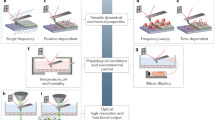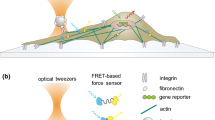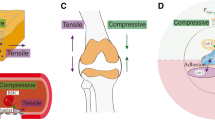Abstract
Living cells are sensitive to their mechanical environments and they transduce mechanical stimuli into biological responses. Developing suitable experimental techniques is essential to explore the question on how cells respond to mechanical stimuli. The current major techniques normally induce small cell deformations and measure their corresponding cell force response (small) in the range of 1 pN to 10nN. However, in many physiological conditions, cell deformations can be large (comparable to the cell sizes) inducing large force response. In order to explore cell mechanical behavior under large deformations, we introduce a class of microfabricated force sensors. The sensors, consisting of a probe and flexible beams, normally measure cell force response in the range of 1nN to 1μN. Both the one- and two-component force sensors have been developed, and have been used in cell experiments. These experiments showed the versatility of the force sensors. Representative experimental results on cell stretch force response, cell indentation force response, and in situ observation of the actin cytoskeleton during indentation, will be given. These results provide significant insight on cell mechanical response under large deformations.












Similar content being viewed by others
References
Bao G, Suresh S (2003) Cell and molecular mechanics of biological materials. Nat Mater 2(11):715–725.
Vogel V (2006) Mechanotransduction involving multimodular proteins: converting force into biochemical signals. Annu Rev Biophys Biomol Struct 35:459–488.
Ingber DE (2006) Cellular mechanotransduction: putting all the pieces together again. FASEB J 20:811–827.
Wang N, Butler JP, Ingber DE (1993) Mechanotransduction across the cell surface and through the cytoskeleton. Science 260(5111):1124–1127.
Chen CS, Mrksich M, Huang S, Whitesides GM, Ingber DE (1997) Geometric control of cell life and death. Science 276(5317):1425–1428.
Balaban NQ et al. (2001) Force and focal adhesion assembly: a close relationship studied using elastic micropatterned substrates. Nat Cell Biol 3(5):466–472.
Suresh S et al (2005) Connections between single-cell biomechanics and human disease states: gastrointestinal cancer and malaria. Acta Biomater 1(1):15–30.
Engler AJ, Sen S, Sweeney HL, Discher DE (2006) Matrix elasticity directs stem cell lineage specification. Cell 126(4):677–689.
Van Vliet KJ, Bao G, Suresh S (2003) The biomechanics toolbox: experimental approaches for living cells and biomolecules. Acta Mater 51(19):5881–5905.
Silver FH (1987) Biological materials: Structure, mechanical properties, and modeling of soft tissues. New York, University Press.
Maurel W, Wu Y, Magnenat Thalmann N, Thalmann D (1998) Biomechanical models for soft tissue simulation. Springer-Verlag, Berlin.
Pfister BJ, Weihs TP, Betenbaugh M, Bao G (2003) An in vitro uniaxial stretch model for axonal injury. Ann Biomed Eng 31(5):589–598.
Galbraith CG, Sheetz MP (1997) A micromachined device provides a new bend on fibroblast traction forces. Proc Natl Acad Sci USA 94(17):9114–9118.
Tan JL, Tien J, Pirone DM, Gray DS, Bhadriraju K, Chen CS (2003) Cells lying on a bed of microneedles: An approach to isolate mechanical force. Proc Natl Acad Sci USA 100(4):1484–1489.
du Roure O, Saez A, Buguin A, Austin RH, Chavrier P, Silberzan P, Ladoux B (2005) Force mapping in epithelial cell migration. Proc Natl Acad Sci USA 102(7):2390–2395.
Zhao Y, Lim CC, Sawyer DB, Liao R, Zhang X (2005) Cellular force measurements using single-spaced polymeric microstructures: isolating cells from base substrate. J Micromech Microeng 15(9):1649–1656.
Sniadecki NJ, Desai RA, Ruiz SA, Chen CS (2006) Nanotechnology for cell-substrate interactions. Ann Biomed Eng 34(1):59–74.
Zimerman B, Arnold M, Ulmer J, Blummel J, Besser A, Spatz JP, Geiger B (2004) Formation of focal adhesion-stress fibre complexes coordinated by adhesive and non-adhesive surface domains. IEE Proc-Nanobiotechnol 151(2):62–66.
Chen CS, Jiang X, Whitesides GM (2005) Microengineering the environment of mammalian cells in culture. MRS Bulletin 30(3):194–201.
Gallant ND, Michael KE, Garcia AJ (2005) Cell adhesion strengthening: contributions of adhesive area, integrin binding, and focal adhesion assembly. Mol Biol Cell 16(9):4329–4340.
Khademhosseini A, Langer R, Borenstein J, Vacanti JP (2006) Microscale technologies for tissue engineering and biology. Proc Natl Acad Sci USA 103(8):2480–2487.
Kim DH, Kim P, Song I, Cha JM, Lee SH, Kim B, Suh KY (2006) Guided three-dimensional growth of functional cardiomyocytes on polyethylene glycol nanostructures. Langmuir 22(12):5419–5426.
Steinberg T, Schulz S, Spatz JP, Grabe N, Mussig E, Kohl A, Komposch G, Tomakidi P (2007) Early keratinocyte differentiation on micropillar interfaces. Nano Letters 7(2):287–294.
Cavalcanti-Adam EA, Volberg T, Micoulet A, Kessler H, Geiger B, Spatz JP (2007) Cell spreading and focal adhesion dynamics are regulated by spacing of integrin ligands. Biophys J 92(8):2964–2974.
Walker GM, Zeringue HC, Beebe DJ (2004) Microenvironment design considerations for cellular scale studies. Lab Chip 4(2):91–97.
Hu X, Bessette PH, Qian J, Meinhart CD, Daugherty PS, Soh HT (2005) Marker-specific sorting of rare cells using dielectrophoresis. Proc Natl Acad Sci USA 102(44):15757–15761.
El-Ali J, Sorger PK, Jensen KF (2006) Cells on chips. Nature 442(7101):403–411.
Weibel DB, DiLuzio WR, Whitesides GM (2007) Microfabrication meets microbiology. Nat Rev Microbiol 5(3):209–218.
Yang S, Saif T (2005) Micromachined force sensors for the study of cell mechanics. Rev Sci Instrum 76(4):044301.
Yang S, Saif MTA (2007) MEMS based force sensors for the study of indentation response of single living cells. Sens Actuat A 135(1):16–22.
Shaw KA, Zhang ZL, MacDonald NC (1994) SCREAM-I: a single mask, single crystal silicon, reactive etching process for microelectromechanical structures. Sens Actuat A 40(1):63–70.
Yamamoto A, Mishima S, Maruyama N, Sumita M (1998) A new technique for direct measurement of the shear force necessary to detach a cell from a material. Biomaterials 19(7–9):871–879.
Yang S, Saif T (2005) Reversible and repeatable linear local cell force response under large stretches. Exp Cell Res 305(1):42–50.
Petersen NO, McConnaughey WB, Elson EL (1982) Dependence of locally measured cellular deformability on position on the cell, temperature, and cytochalasin B. Proc Natl Acad Sci USA 79(17):5327–5331.
Touhami A, Nysten B, Dufrene YF (2003) Nanoscale mapping of the elasticity of microbial cells by atomic force microscopy. Langmuir 19(11):4539–4543.
Thoumine O, Ott A (1997) Time scale dependent viscoelastic and contractile regimes in fibroblasts probed by microplate manipulation. J. Cell Sci. 110(17):2109–2116.
An SS, Laudadio RE, Lai J, Rogers RA, Fredberg JJ (2002) Stiffness changes in cultured airway smooth muscle cells. Am J Physiol Cell Physiol 283(3):C792–C801.
Hayashi K (2003) Mechanical properties of soft tissues and arterial walls. In: GA Holzapfel, RW Ogden (eds) Biomechanics of soft Tissue in Cardiovascular System. Springer Wien, New York, pp 15–64.
Yang S, Saif MTA (2007) Force response and actin remodeling (agglomeration) in fibroblasts due to lateral indentation. Acta Biomater 3(1):77–87.
Sattler R, Xiong Z, Lu WY, MacDonald JF, Tymianski M (2000) Distinct roles of synaptic and extrasynaptic NMDA receptors in excitotoxicity. J Neurosci 20(1):22–33.
Niciforovic A, Radojcic MB, Milosavljevic BH (2004) Gamma-radiation induced agglomeration of chicken muscle myosin and actin. J Serb Chem Soc 69(12):999–1004.
Gerisch G, Bretschneider T, Muller-Taubenberger A, Simmeth E, Ecke M, Diez S, Anderson K (2004) Mobile actin clusters and traveling waves in cells recovering from actin depolymerization. Biophy J 87(5):3493–3503.
Ashworth SL, Southgate EL, Sandoval RM, Meberg PJ, Bamburg JR, Molitoris BA (2003) ADF/cofilin mediates actin cytoskeletal alterations in LLC-PK cells during ATP depletion. Am J Physiol Renal Physiol 28(44):F852–F862.
Schmidt Capella IC, Hartfelder K (2002) Juvenile-hormone-dependent interaction of actin and spectrin is crucial for polymorphic differentiation of the larval honey bee ovary. Cell Tissue Res 307(2):265–272.
Charras GT, Horton MA (2002) Single cell mechanotransduction and its modulation analyzed by atomic force microscope indentation. Biophys J 82(6):2970–2981.
Feneberg W, Aepfelbacher M, Sackmann E (2004) Microviscoelasticity of the apical cell surface of human umbilical vein endothelial cells (HUVEC) within confluent monolayers. Biophys J 87(2):1338–1350.
Acknowledgements
We thank Professor Ning Wang of the University of Illinois at Urbana-Champaign, Professor Subra Suresh and Professor Roger Kamm of the Massachusetts Institute of Technology, Professor Erich Sackmann of the Technical University of Munich, Professor Vladimir Gelfand of Northwestern University, and Professor Thomas Eurell of Colorado State University for helpful discussions. The HUVEC cells were provided by Professor Thomas Eurell. This work was supported by the National Science Foundation (NSF) grants ECS 01-18003 and ECS 05-24675. The MEMS force sensors were fabricated at the Center for Nanoscale Science and Technology at the University of Illinois at Urbana-Champaign.
Author information
Authors and Affiliations
Corresponding author
Rights and permissions
About this article
Cite this article
Yang, S., Saif, M.T.A. Microfabricated Force Sensors and Their Applications in the Study of Cell Mechanical Response. Exp Mech 49, 135–151 (2009). https://doi.org/10.1007/s11340-007-9119-8
Received:
Accepted:
Published:
Issue Date:
DOI: https://doi.org/10.1007/s11340-007-9119-8




